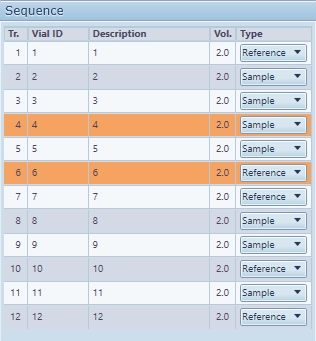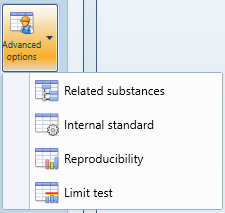Definition¶

The Definition tab is used to:
A: Sequence - Configure the sample and reference tracks
B: Substance Table - Configure the substances being analyzed during the evaluation
C: References - Configure the reference concentration and purity of the reference vials
D: Samples - Configure the sample reference amounts for the evaluation
The Sequence panel (left) recalls the contents of the sequence table (see Sample Sequence for more details).
The Substance table grid and the References grid have fixed rows and are synchronized : a given column represents the same substance on each grid.
Important
The Sequence, References and Samples areas are only available in analysis files.
Sequence¶
The Sample Sequence already defines the sample tracks and the reference tracks for the current analysis, but it can happen that this configuration has to be modified for a given evaluation (for example to test different configurations in several evaluations). Since visionCATS 2.1, you can use the combo box next to each track to configure individual vial applications. When you change the type of a vial application, the References and Samples sections of the current tab are modified accordingly, and the vial application is displayed with an orange background (e.g. tracks 4 and 6 in the following screen capture) if the type is not the same as the one defined in the global Sample Sequence.

Substance Table¶
In this view, the column header of the grid contains the global actions related to the substance definition: an add button, a delete button, and an eventual warning button if the definition is invalid (here for example the substance is already defined):

The following parameters can be defined for a given substance:
Name: choose an existing substance or create a new one. If a substance is not known at this stage, you can add it later during the Substance Assignment step.
Rf and ΔRf: position and range of the expected peaks for this substance (between 0 and 1). During the Substance Assignment phase, the automatic assignment will search at this position by default but you will be able to set this position manually if needed. You can ignore this fields in the Definition phase if you don’t know where the peaks will appear at this time.
λ: wavelength. The dropdown list contains all illuminations (for Visualizer steps) and wavelengths (for Scanner steps) used in the current method/analysis. If the wavelength is set, the automatic assignment will try to assign peaks of this wavelength. Otherwise, the best peak is chosen.
Calibration type: indicates whether the height or the area of a peak is used to produce the reference and the sample points during the calibration phase. You can also set this value during the Calibration phase. Therefore, you can ignore it if you don’t know what to choose at this time.
Calibration mode: indicates which regression algorithm is used in the Calibration phase. You can also set this value during the Calibration phase. Therefore, you can ignore it if you don’t know what to choose at this time.
Range deviation: during the calibration, the range is the interval between the minimum and the maximum applied quantity in reference applications for a given substance. Sample applications outside this range are excluded from the results by default (i.e.: when Range deviation =0%). Use the Range deviation to allow samples to be included outside the range. The value given is the percentage of the range allowed before the minimum and after the maximum. When using the Linear-1 regression with one reference regression point, visionCATS uses the interval between the origin and the reference regression point.
Note
Use the Reuse substances
Advanced options are available when hitting the button on the right of the panel, allowing you to enable the and/or the functionalities:

Related Substances: define a main substance and some related substances for this evaluation.
Internal standard: define a substance as internal standard for this evaluation.
Reproducibility: evaluate the reproducibility for some substances in this evaluation.
Limit Test: perform a limit test on some substances in this evaluation.
References¶
Define in this grid view the concentration (and purity) values for the interesting substance/reference vial couples, as well as the concentration unit type. The unit type is unique for the whole evaluation in order to prevent inconsistencies. You can choose between:
Mass / volume: this is the default and probably the most used mode. Results are expressed in mass unit.
Volume / volume: results are expressed in volume unit. Use this mode to express relative concentrations. As an example, ppm is equivalent to nl/ml.
Molarity: results are expressed in mole unit.
The corresponding substance/vials concentration in the grid, associated with the volume, gives the amount applied on which the quantification is based.
Each cell in this grid view can have a concentration/purity value. The concentration is always expressed with a maximum of 3 digits.
Note
visionCATS automatically adjusts the unit based on the concentration you enter. In the Calibration and the Results steps, quantities and concentrations are always shown in the most suitable unit.
When nothing is shown or when the concentration value is empty or 0.00, the link between the substance and the vial doesn’t exist or will be deleted during the next save operation.
At first, you will only see a  , click on it to enter values.
, click on it to enter values.
If the concentration is 0.00 or the purity is invalid, a  will be displayed.
will be displayed.
The link between a reference vial and a substance concentration/volume is global: if another evaluation has already defined this link, it will be automatically filled and in read only mode. The status is represented by  .
.
Note
Use the Substance/Vial editor to find and configure the substance/vial concentration defined in the current visionCATS installation.
Samples¶
Use this tab to define the sample reference amounts. Sample reference amounts allow you to express the results of an evaluation in a more user-friendly manner than a concentration. You can define a sample reference amount for each sample vial applied in the current evaluation. The values in this tab only influence the Results displayed at the end of the evaluation.
As an example, the following configuration:

Indicates that the sample vial S3570_150105 has been obtained by diluting 1.375g (Amount) of a given product in 500ml (the Volume solution). The given product was a tablet (field Related to) of 1g (Reference amount). With this configuration, the Results will show the quantity of substance in the original tablet in addition to the main result (concentration of substance in the sample vial).